Strategies for Enhancing Communication in Multinational Companies
VerifiedAdded on 2020/02/18
|7
|1390
|84
Report
AI Summary
This report analyzes communication challenges within a multinational company, focusing on cross-cultural communication barriers and digital literacy discrepancies. The report highlights the importance of effective communication in business organizations, citing issues such as client and employee dissatisfaction resulting from poor communication. It examines good practices, including the 7 C's of communication and documentation of communications. The report then explores future strategies to address cross-cultural issues through employee awareness and team-building activities, and discrepancies in digital literacy through training programs. The conclusion emphasizes the implications of effective communication on business success, customer satisfaction, and employee retention, while also suggesting changes in organizational culture and structure to ensure effective communication. The report references case studies and relevant literature to support its arguments.
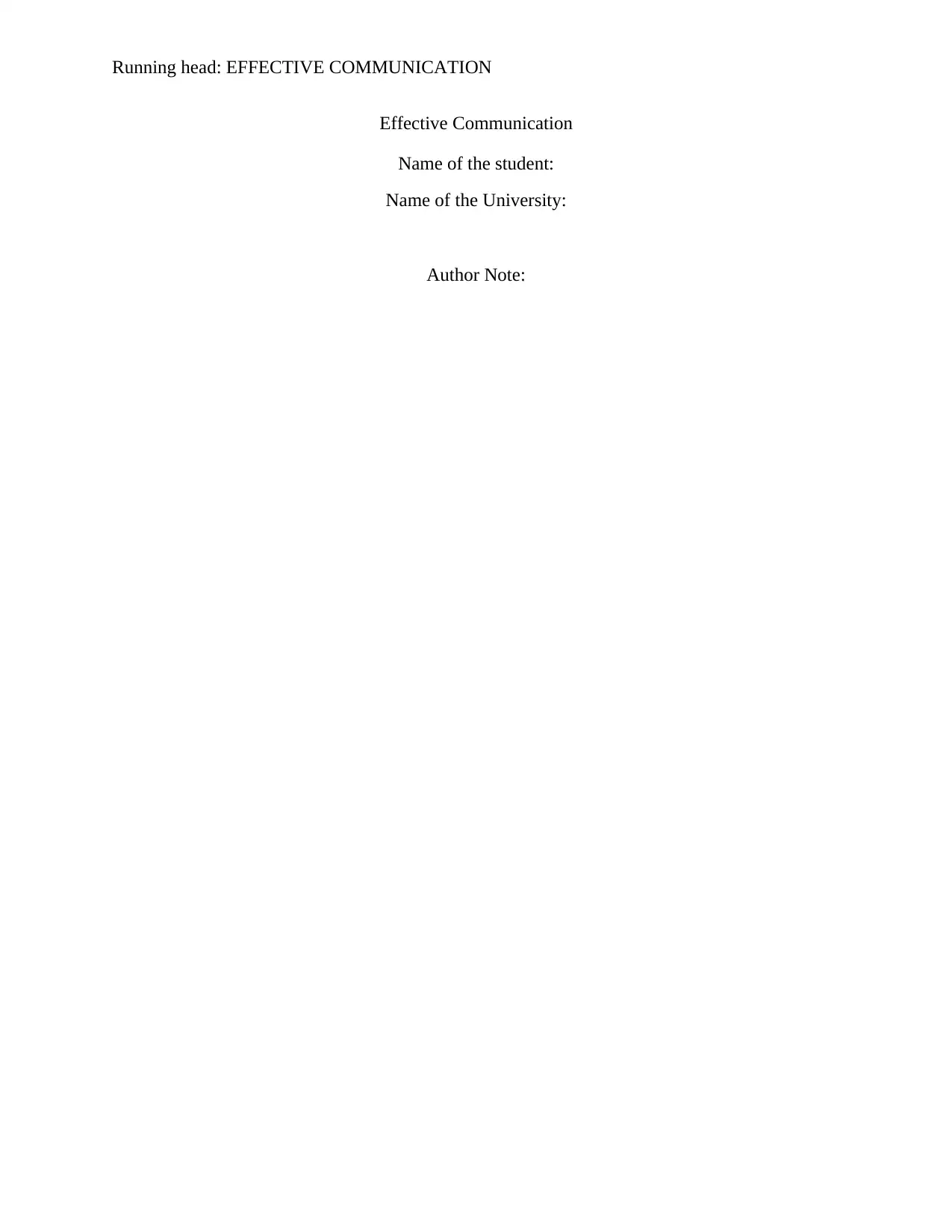
Running head: EFFECTIVE COMMUNICATION
Effective Communication
Name of the student:
Name of the University:
Author Note:
Effective Communication
Name of the student:
Name of the University:
Author Note:
Paraphrase This Document
Need a fresh take? Get an instant paraphrase of this document with our AI Paraphraser
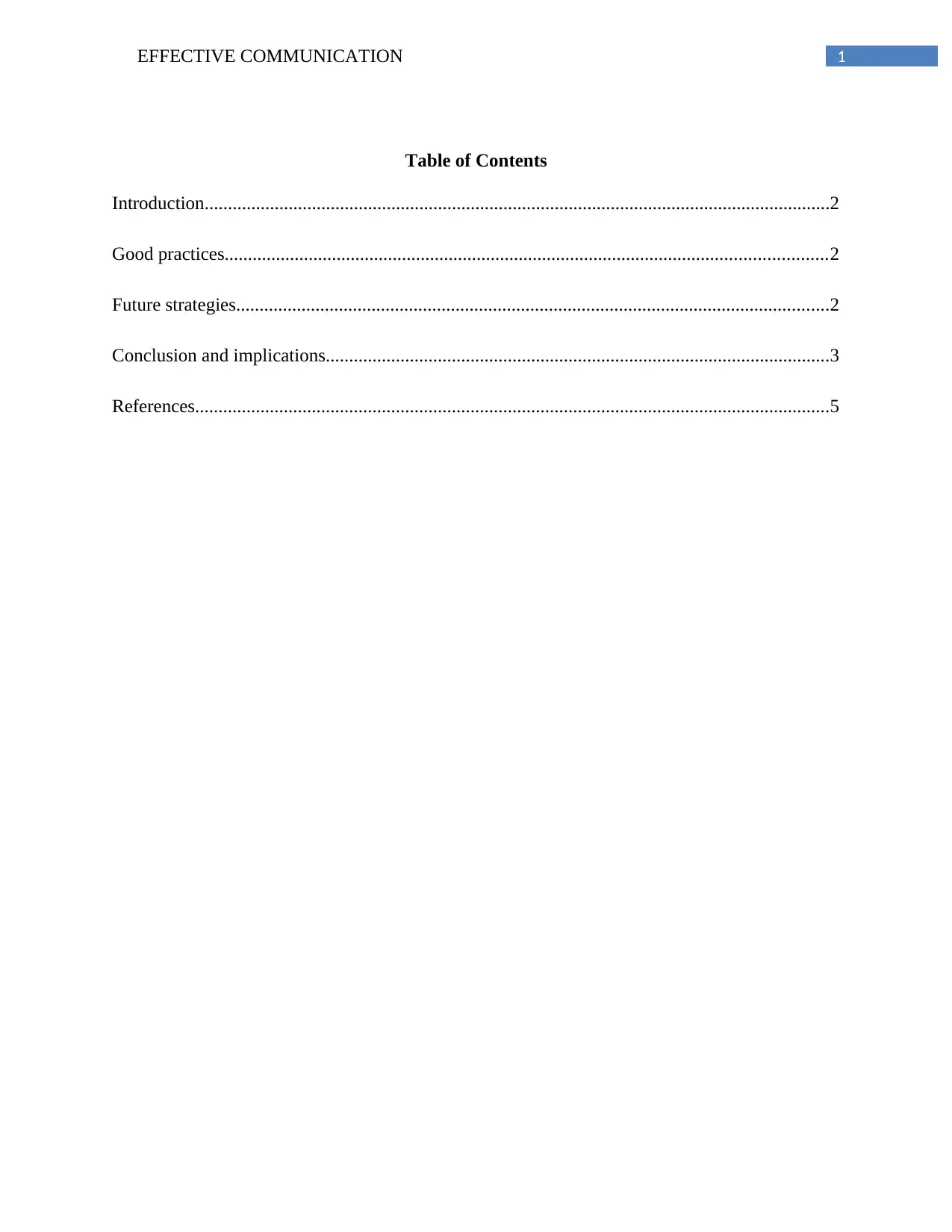
1EFFECTIVE COMMUNICATION
Table of Contents
Introduction......................................................................................................................................2
Good practices.................................................................................................................................2
Future strategies...............................................................................................................................2
Conclusion and implications............................................................................................................3
References........................................................................................................................................5
Table of Contents
Introduction......................................................................................................................................2
Good practices.................................................................................................................................2
Future strategies...............................................................................................................................2
Conclusion and implications............................................................................................................3
References........................................................................................................................................5
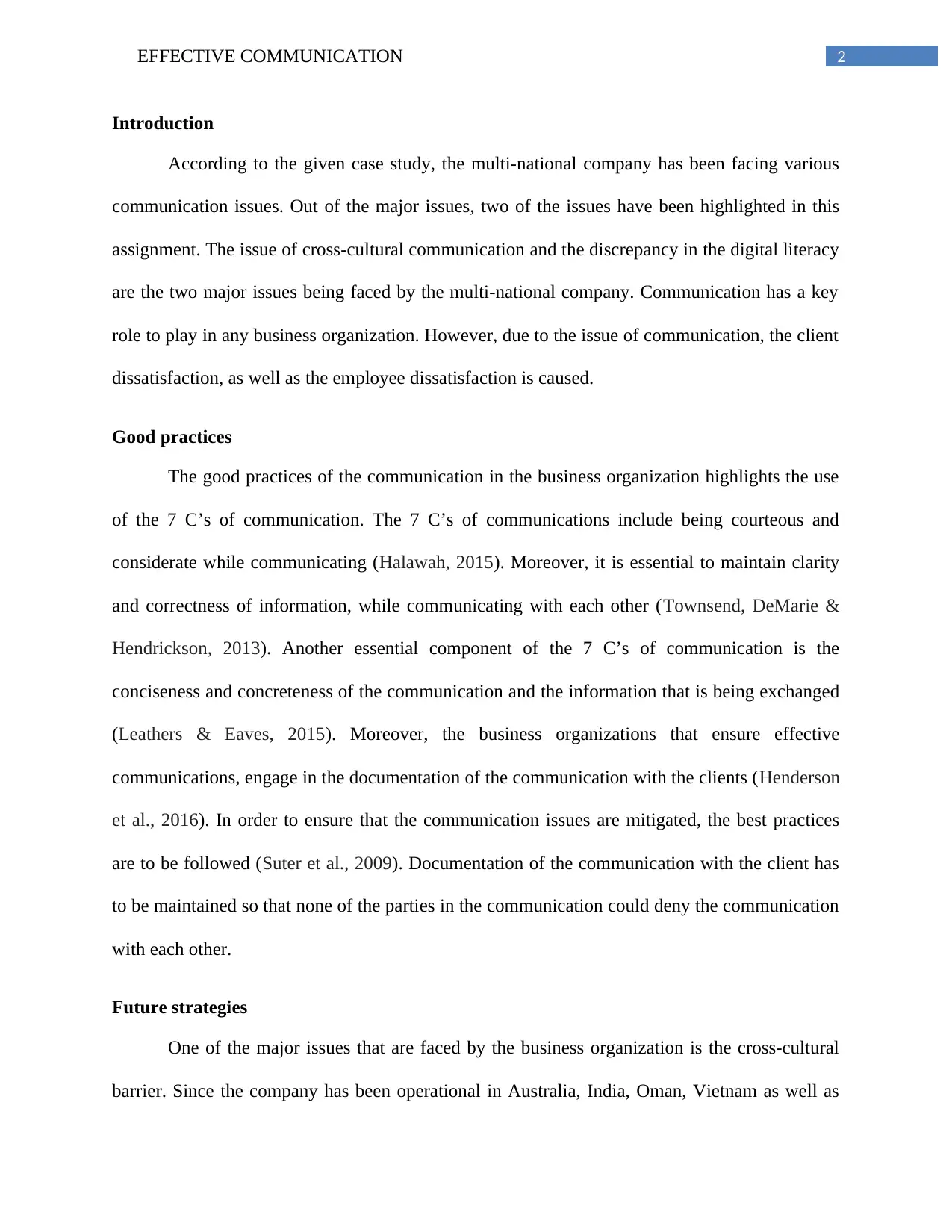
2EFFECTIVE COMMUNICATION
Introduction
According to the given case study, the multi-national company has been facing various
communication issues. Out of the major issues, two of the issues have been highlighted in this
assignment. The issue of cross-cultural communication and the discrepancy in the digital literacy
are the two major issues being faced by the multi-national company. Communication has a key
role to play in any business organization. However, due to the issue of communication, the client
dissatisfaction, as well as the employee dissatisfaction is caused.
Good practices
The good practices of the communication in the business organization highlights the use
of the 7 C’s of communication. The 7 C’s of communications include being courteous and
considerate while communicating (Halawah, 2015). Moreover, it is essential to maintain clarity
and correctness of information, while communicating with each other (Townsend, DeMarie &
Hendrickson, 2013). Another essential component of the 7 C’s of communication is the
conciseness and concreteness of the communication and the information that is being exchanged
(Leathers & Eaves, 2015). Moreover, the business organizations that ensure effective
communications, engage in the documentation of the communication with the clients (Henderson
et al., 2016). In order to ensure that the communication issues are mitigated, the best practices
are to be followed (Suter et al., 2009). Documentation of the communication with the client has
to be maintained so that none of the parties in the communication could deny the communication
with each other.
Future strategies
One of the major issues that are faced by the business organization is the cross-cultural
barrier. Since the company has been operational in Australia, India, Oman, Vietnam as well as
Introduction
According to the given case study, the multi-national company has been facing various
communication issues. Out of the major issues, two of the issues have been highlighted in this
assignment. The issue of cross-cultural communication and the discrepancy in the digital literacy
are the two major issues being faced by the multi-national company. Communication has a key
role to play in any business organization. However, due to the issue of communication, the client
dissatisfaction, as well as the employee dissatisfaction is caused.
Good practices
The good practices of the communication in the business organization highlights the use
of the 7 C’s of communication. The 7 C’s of communications include being courteous and
considerate while communicating (Halawah, 2015). Moreover, it is essential to maintain clarity
and correctness of information, while communicating with each other (Townsend, DeMarie &
Hendrickson, 2013). Another essential component of the 7 C’s of communication is the
conciseness and concreteness of the communication and the information that is being exchanged
(Leathers & Eaves, 2015). Moreover, the business organizations that ensure effective
communications, engage in the documentation of the communication with the clients (Henderson
et al., 2016). In order to ensure that the communication issues are mitigated, the best practices
are to be followed (Suter et al., 2009). Documentation of the communication with the client has
to be maintained so that none of the parties in the communication could deny the communication
with each other.
Future strategies
One of the major issues that are faced by the business organization is the cross-cultural
barrier. Since the company has been operational in Australia, India, Oman, Vietnam as well as
⊘ This is a preview!⊘
Do you want full access?
Subscribe today to unlock all pages.

Trusted by 1+ million students worldwide
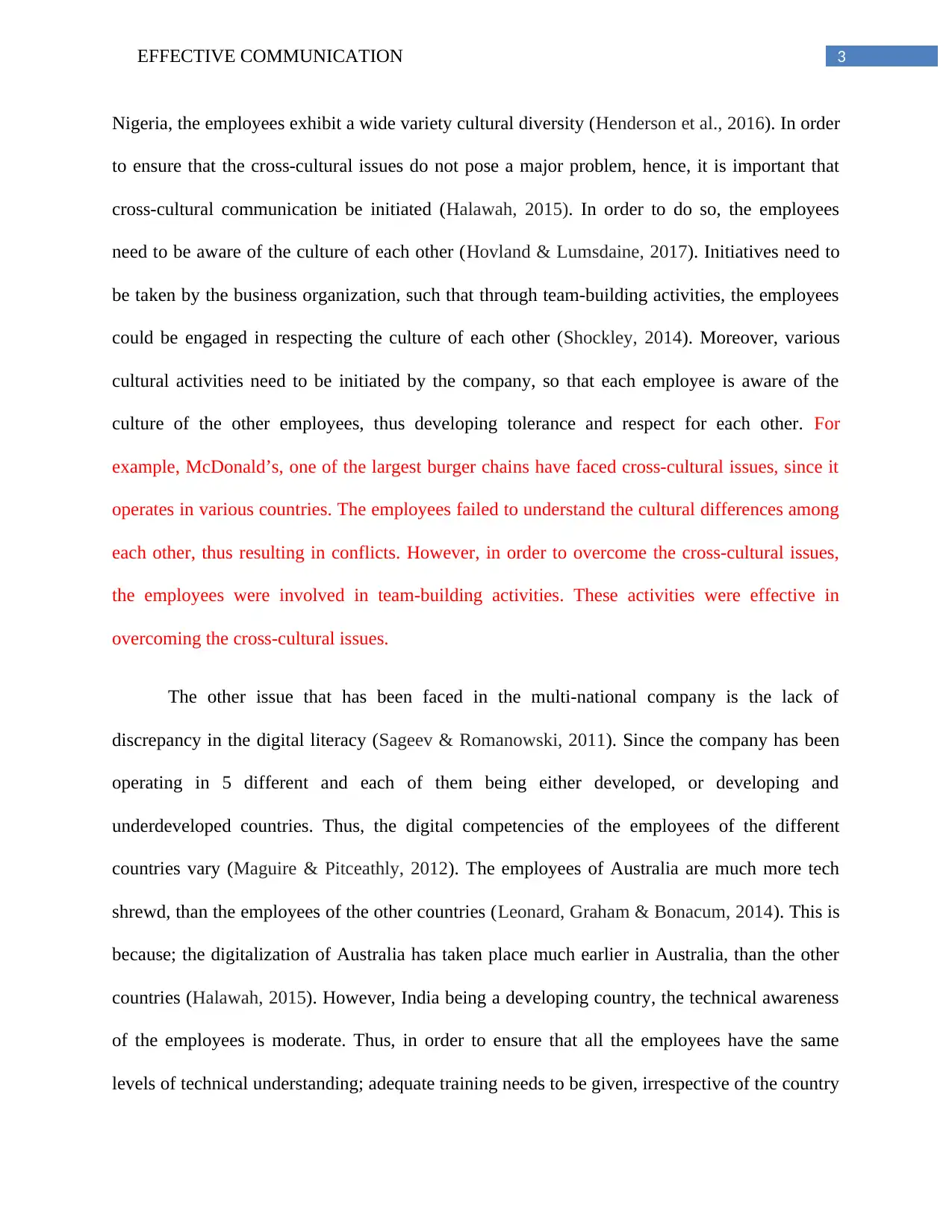
3EFFECTIVE COMMUNICATION
Nigeria, the employees exhibit a wide variety cultural diversity (Henderson et al., 2016). In order
to ensure that the cross-cultural issues do not pose a major problem, hence, it is important that
cross-cultural communication be initiated (Halawah, 2015). In order to do so, the employees
need to be aware of the culture of each other (Hovland & Lumsdaine, 2017). Initiatives need to
be taken by the business organization, such that through team-building activities, the employees
could be engaged in respecting the culture of each other (Shockley, 2014). Moreover, various
cultural activities need to be initiated by the company, so that each employee is aware of the
culture of the other employees, thus developing tolerance and respect for each other. For
example, McDonald’s, one of the largest burger chains have faced cross-cultural issues, since it
operates in various countries. The employees failed to understand the cultural differences among
each other, thus resulting in conflicts. However, in order to overcome the cross-cultural issues,
the employees were involved in team-building activities. These activities were effective in
overcoming the cross-cultural issues.
The other issue that has been faced in the multi-national company is the lack of
discrepancy in the digital literacy (Sageev & Romanowski, 2011). Since the company has been
operating in 5 different and each of them being either developed, or developing and
underdeveloped countries. Thus, the digital competencies of the employees of the different
countries vary (Maguire & Pitceathly, 2012). The employees of Australia are much more tech
shrewd, than the employees of the other countries (Leonard, Graham & Bonacum, 2014). This is
because; the digitalization of Australia has taken place much earlier in Australia, than the other
countries (Halawah, 2015). However, India being a developing country, the technical awareness
of the employees is moderate. Thus, in order to ensure that all the employees have the same
levels of technical understanding; adequate training needs to be given, irrespective of the country
Nigeria, the employees exhibit a wide variety cultural diversity (Henderson et al., 2016). In order
to ensure that the cross-cultural issues do not pose a major problem, hence, it is important that
cross-cultural communication be initiated (Halawah, 2015). In order to do so, the employees
need to be aware of the culture of each other (Hovland & Lumsdaine, 2017). Initiatives need to
be taken by the business organization, such that through team-building activities, the employees
could be engaged in respecting the culture of each other (Shockley, 2014). Moreover, various
cultural activities need to be initiated by the company, so that each employee is aware of the
culture of the other employees, thus developing tolerance and respect for each other. For
example, McDonald’s, one of the largest burger chains have faced cross-cultural issues, since it
operates in various countries. The employees failed to understand the cultural differences among
each other, thus resulting in conflicts. However, in order to overcome the cross-cultural issues,
the employees were involved in team-building activities. These activities were effective in
overcoming the cross-cultural issues.
The other issue that has been faced in the multi-national company is the lack of
discrepancy in the digital literacy (Sageev & Romanowski, 2011). Since the company has been
operating in 5 different and each of them being either developed, or developing and
underdeveloped countries. Thus, the digital competencies of the employees of the different
countries vary (Maguire & Pitceathly, 2012). The employees of Australia are much more tech
shrewd, than the employees of the other countries (Leonard, Graham & Bonacum, 2014). This is
because; the digitalization of Australia has taken place much earlier in Australia, than the other
countries (Halawah, 2015). However, India being a developing country, the technical awareness
of the employees is moderate. Thus, in order to ensure that all the employees have the same
levels of technical understanding; adequate training needs to be given, irrespective of the country
Paraphrase This Document
Need a fresh take? Get an instant paraphrase of this document with our AI Paraphraser
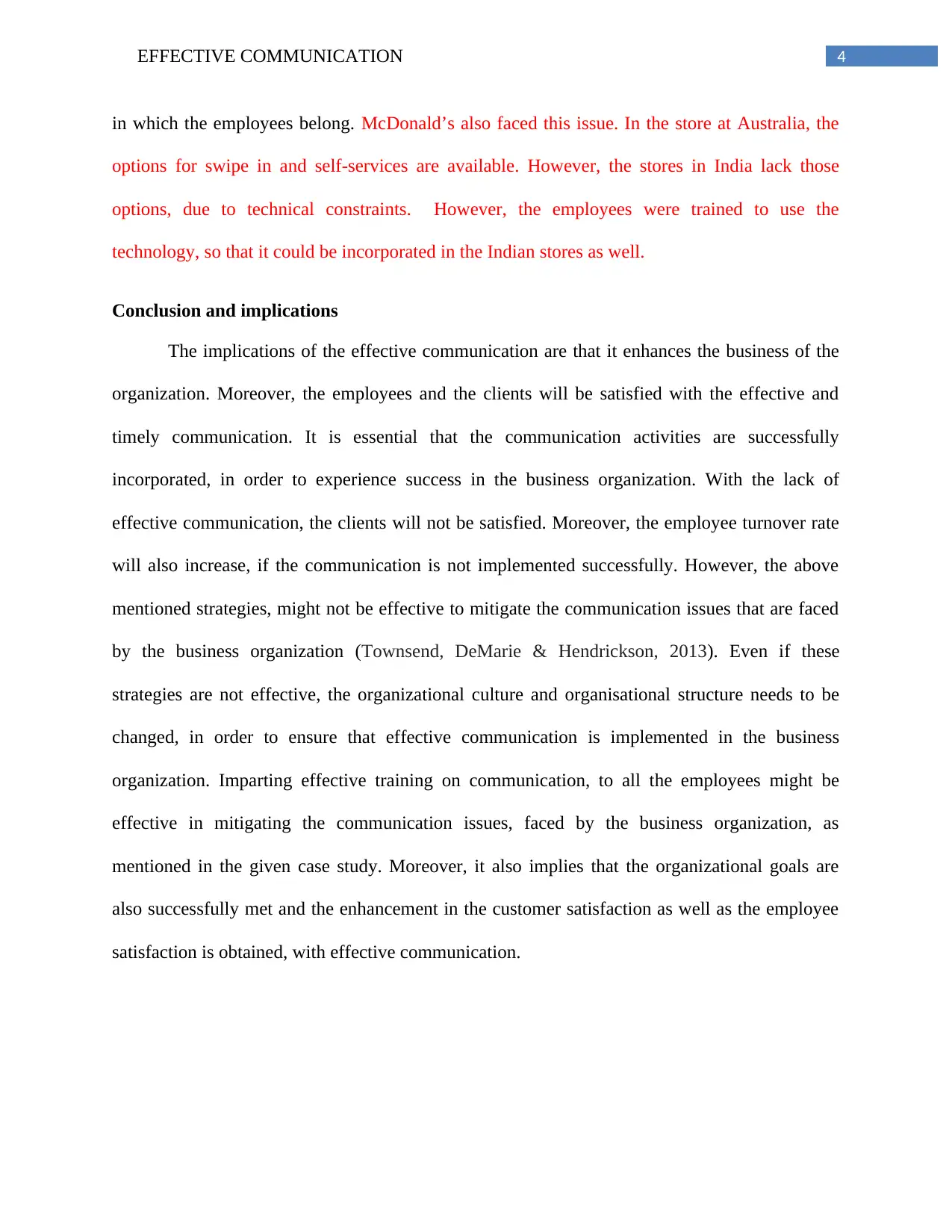
4EFFECTIVE COMMUNICATION
in which the employees belong. McDonald’s also faced this issue. In the store at Australia, the
options for swipe in and self-services are available. However, the stores in India lack those
options, due to technical constraints. However, the employees were trained to use the
technology, so that it could be incorporated in the Indian stores as well.
Conclusion and implications
The implications of the effective communication are that it enhances the business of the
organization. Moreover, the employees and the clients will be satisfied with the effective and
timely communication. It is essential that the communication activities are successfully
incorporated, in order to experience success in the business organization. With the lack of
effective communication, the clients will not be satisfied. Moreover, the employee turnover rate
will also increase, if the communication is not implemented successfully. However, the above
mentioned strategies, might not be effective to mitigate the communication issues that are faced
by the business organization (Townsend, DeMarie & Hendrickson, 2013). Even if these
strategies are not effective, the organizational culture and organisational structure needs to be
changed, in order to ensure that effective communication is implemented in the business
organization. Imparting effective training on communication, to all the employees might be
effective in mitigating the communication issues, faced by the business organization, as
mentioned in the given case study. Moreover, it also implies that the organizational goals are
also successfully met and the enhancement in the customer satisfaction as well as the employee
satisfaction is obtained, with effective communication.
in which the employees belong. McDonald’s also faced this issue. In the store at Australia, the
options for swipe in and self-services are available. However, the stores in India lack those
options, due to technical constraints. However, the employees were trained to use the
technology, so that it could be incorporated in the Indian stores as well.
Conclusion and implications
The implications of the effective communication are that it enhances the business of the
organization. Moreover, the employees and the clients will be satisfied with the effective and
timely communication. It is essential that the communication activities are successfully
incorporated, in order to experience success in the business organization. With the lack of
effective communication, the clients will not be satisfied. Moreover, the employee turnover rate
will also increase, if the communication is not implemented successfully. However, the above
mentioned strategies, might not be effective to mitigate the communication issues that are faced
by the business organization (Townsend, DeMarie & Hendrickson, 2013). Even if these
strategies are not effective, the organizational culture and organisational structure needs to be
changed, in order to ensure that effective communication is implemented in the business
organization. Imparting effective training on communication, to all the employees might be
effective in mitigating the communication issues, faced by the business organization, as
mentioned in the given case study. Moreover, it also implies that the organizational goals are
also successfully met and the enhancement in the customer satisfaction as well as the employee
satisfaction is obtained, with effective communication.
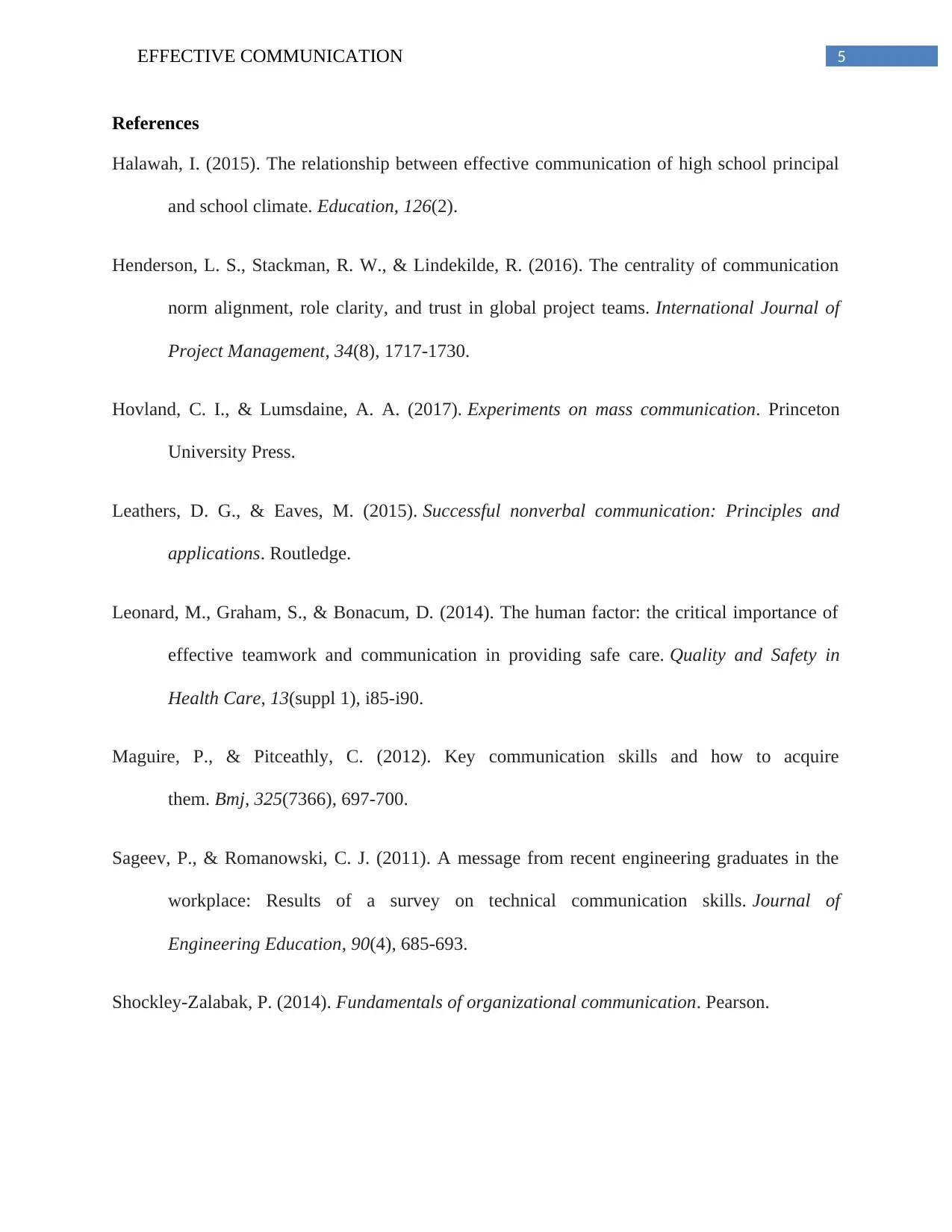
5EFFECTIVE COMMUNICATION
References
Halawah, I. (2015). The relationship between effective communication of high school principal
and school climate. Education, 126(2).
Henderson, L. S., Stackman, R. W., & Lindekilde, R. (2016). The centrality of communication
norm alignment, role clarity, and trust in global project teams. International Journal of
Project Management, 34(8), 1717-1730.
Hovland, C. I., & Lumsdaine, A. A. (2017). Experiments on mass communication. Princeton
University Press.
Leathers, D. G., & Eaves, M. (2015). Successful nonverbal communication: Principles and
applications. Routledge.
Leonard, M., Graham, S., & Bonacum, D. (2014). The human factor: the critical importance of
effective teamwork and communication in providing safe care. Quality and Safety in
Health Care, 13(suppl 1), i85-i90.
Maguire, P., & Pitceathly, C. (2012). Key communication skills and how to acquire
them. Bmj, 325(7366), 697-700.
Sageev, P., & Romanowski, C. J. (2011). A message from recent engineering graduates in the
workplace: Results of a survey on technical communication skills. Journal of
Engineering Education, 90(4), 685-693.
Shockley-Zalabak, P. (2014). Fundamentals of organizational communication. Pearson.
References
Halawah, I. (2015). The relationship between effective communication of high school principal
and school climate. Education, 126(2).
Henderson, L. S., Stackman, R. W., & Lindekilde, R. (2016). The centrality of communication
norm alignment, role clarity, and trust in global project teams. International Journal of
Project Management, 34(8), 1717-1730.
Hovland, C. I., & Lumsdaine, A. A. (2017). Experiments on mass communication. Princeton
University Press.
Leathers, D. G., & Eaves, M. (2015). Successful nonverbal communication: Principles and
applications. Routledge.
Leonard, M., Graham, S., & Bonacum, D. (2014). The human factor: the critical importance of
effective teamwork and communication in providing safe care. Quality and Safety in
Health Care, 13(suppl 1), i85-i90.
Maguire, P., & Pitceathly, C. (2012). Key communication skills and how to acquire
them. Bmj, 325(7366), 697-700.
Sageev, P., & Romanowski, C. J. (2011). A message from recent engineering graduates in the
workplace: Results of a survey on technical communication skills. Journal of
Engineering Education, 90(4), 685-693.
Shockley-Zalabak, P. (2014). Fundamentals of organizational communication. Pearson.
⊘ This is a preview!⊘
Do you want full access?
Subscribe today to unlock all pages.

Trusted by 1+ million students worldwide
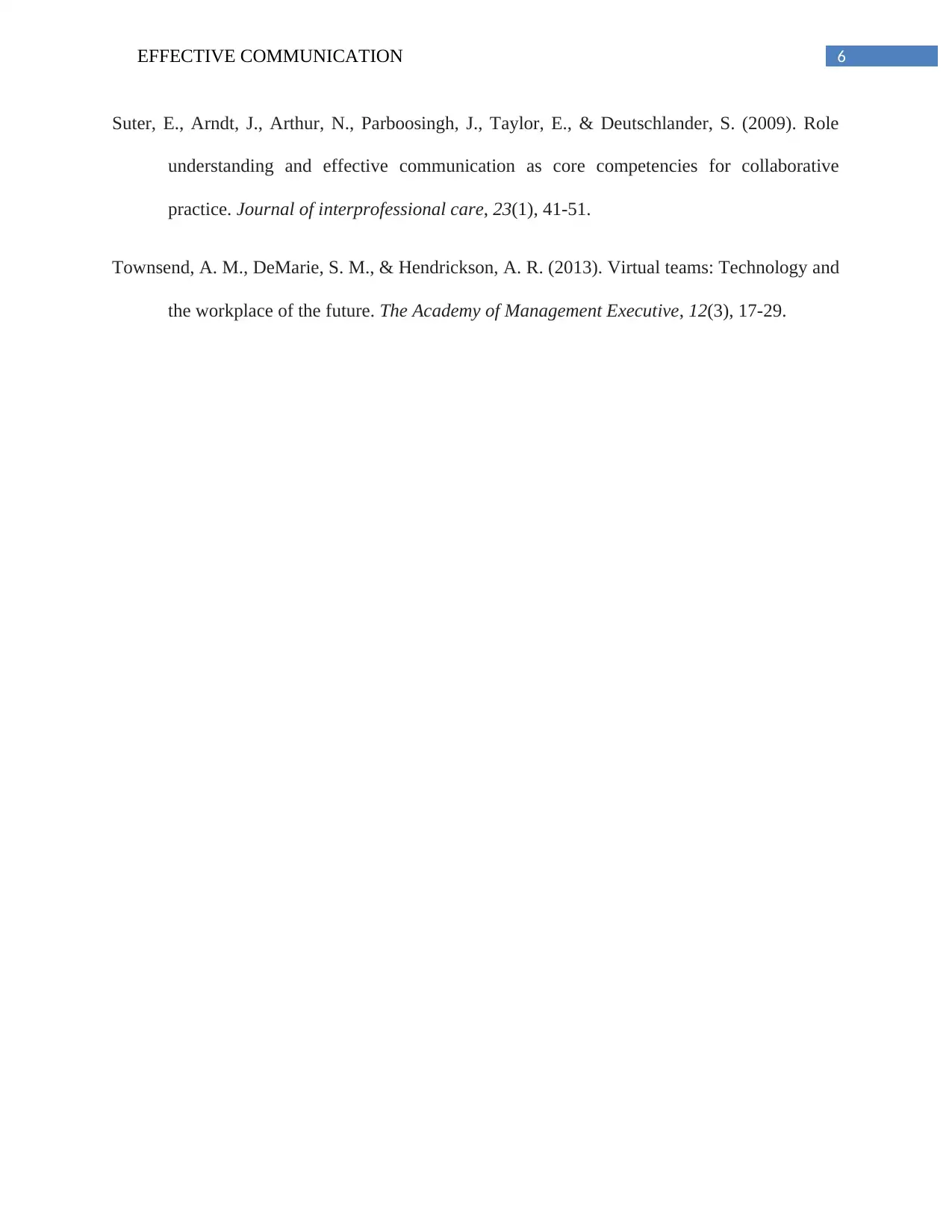
6EFFECTIVE COMMUNICATION
Suter, E., Arndt, J., Arthur, N., Parboosingh, J., Taylor, E., & Deutschlander, S. (2009). Role
understanding and effective communication as core competencies for collaborative
practice. Journal of interprofessional care, 23(1), 41-51.
Townsend, A. M., DeMarie, S. M., & Hendrickson, A. R. (2013). Virtual teams: Technology and
the workplace of the future. The Academy of Management Executive, 12(3), 17-29.
Suter, E., Arndt, J., Arthur, N., Parboosingh, J., Taylor, E., & Deutschlander, S. (2009). Role
understanding and effective communication as core competencies for collaborative
practice. Journal of interprofessional care, 23(1), 41-51.
Townsend, A. M., DeMarie, S. M., & Hendrickson, A. R. (2013). Virtual teams: Technology and
the workplace of the future. The Academy of Management Executive, 12(3), 17-29.
1 out of 7
Related Documents
Your All-in-One AI-Powered Toolkit for Academic Success.
+13062052269
info@desklib.com
Available 24*7 on WhatsApp / Email
![[object Object]](/_next/static/media/star-bottom.7253800d.svg)
Unlock your academic potential
Copyright © 2020–2025 A2Z Services. All Rights Reserved. Developed and managed by ZUCOL.





